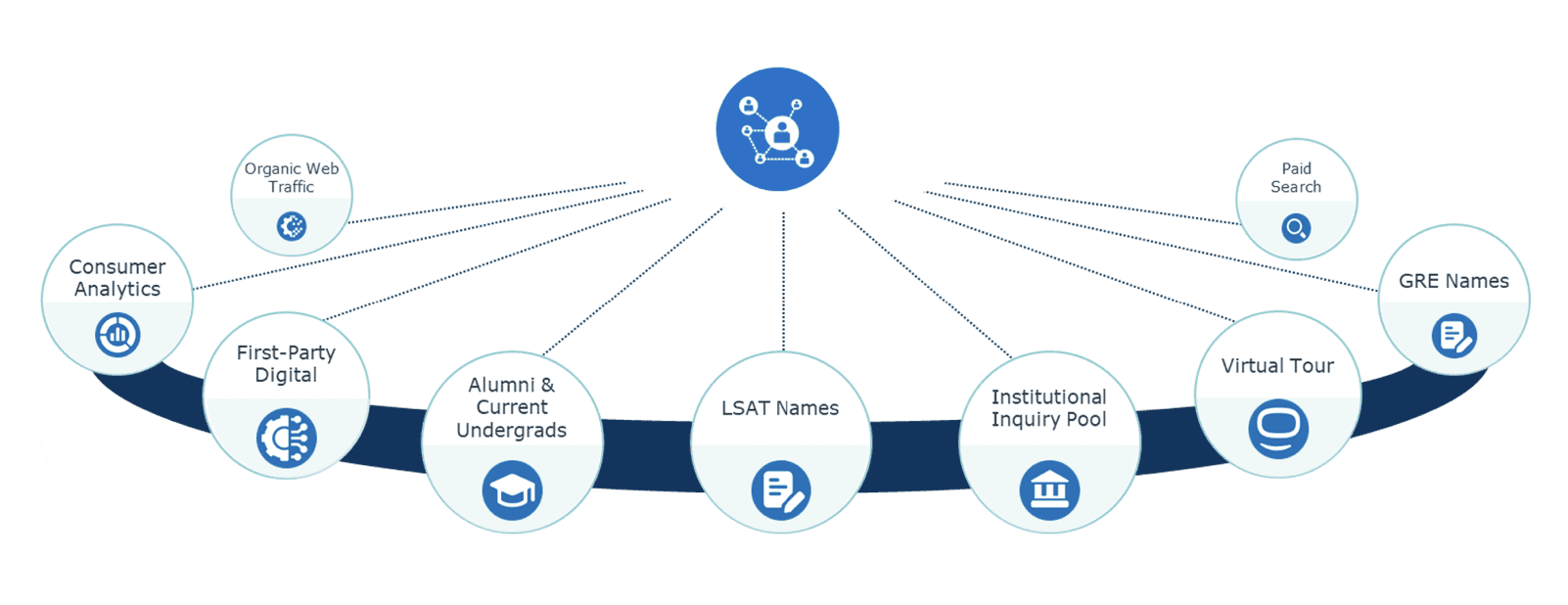2 emerging law school recruitment challenges – and how to address them
In the last 20 years, law school enrollment has been anything but consistent. In just a five-year period, from 2010 to 2015, the number of first-year law students decreased by more than 29%. Then, from 2015 to 2020, the number of first-year law students increased by 3%. And in 2021 – due in part to the pandemic, political shifts, and LSAT exam delivery changes – law school enrollment and median LSAT scores spiked. These ups and downs have made predicting your law school class incredibly difficult, and we expect that this market will continue to evolve quickly.

As you know, law school enrollment goals are not just about overall enrollment numbers. Many of the leaders I work with through our Law School Enrollment Services initiative are trying to improve their class profiles by increasing LSAT and GPA medians, racial and ethnic diversity, and geographic diversity. For the 2022 cycle, law school applications are down. Even more notably, applications from diverse and high-scoring LSAT candidates are down, making curating your ideal law class a daunting task.
At the end of the day, having a consistent strategy will mean the difference between letting the enrollment landscape dictate your class and letting your goals dictate your class. Here are two emerging law school recruitment challenges, and how to address them with a consistent, long-term strategy.
Challenge #1: 30% of LSAT names are not available to Law Schools
In recent conversations with LSAC, some of our partners confirmed that around 30% of LSAT takers are now opting out of the Candidate Referral Service (CRS). That means that not only is the number of test-takers declining, but 30% of those prospective students’ names are not available to law schools to market to.
Solution: Diversify your lead generation sources
It’s likely that LSAT test-takers have been a consistent source of leads for your law school. But given the increasing opt-out rate for the CRS, it might be time to rethink putting so many eggs in the LSAT basket. Diversifying your lead generation strategy and expanding your audience sources will allow you to reach more viable candidates.
If you are not already doing so, consider generating leads from sources such as:
- First-party digital
- Your current undergrads
- Your institution’s inquiry pool
- GRE names
- Paid search
Range of Potential Lead Generation Sources

SEE HOW A DIVERSE LEAD GENERATION STRATEGY HELPED ONE LAW SCHOOL EXCEED THEIR ENROLLMENT GOAL
By reaching out to prospects from a range of sources via a variety of mediums—like direct mail, social media, emails, and digital ads—you can cast a wider net, giving you the best opportunity to shape your desired law school class.
Challenge #2: Competition for viable prospects is heating up
As the number of law school applications tapers off, competition for highly sought-after prospects is becoming fiercer. This means it is more important than ever to stand out to your prospective law students while also expanding your reach into new markets. The inconsistent and linear drip campaigns that many law schools use won’t be enough to build student affinity.
Solution: Drive interest and applications through persistent and persuasive marketing
Once prospects enter your marketing campaigns, your law school has a chance to really stand out among the competition. We know that every prospective law student takes a different path to enrollment, so it is important that your campaigns acknowledges each student’s unique mindsets, motivations, and timelines. Given that the average time a prospect takes to apply to law schools is more than 100 days, consistent marketing, including reminders and encouragement to apply, are imperative to your recruitment strategy.
-
52%
Of LSAT records identified as overlapping from previous years, meaning over half of major list source retest.
-
37%
Of FY21 apps were first contacted in the FY20 cycle, indicating these prospects do in-fact take longer than a traditional cycle to apply.
By ensuring your marketing campaigns are persuasive and persistent, your prospects will be more engaged regardless of where they are in their enrollment journey, and therefore more likely to apply. Staying in contact with and personalizing the campaign experience based on where applicants are in their law school journey can make a big difference. For example, your outreach to prospects shouldn’t end after a year, and it shouldn’t say “Enroll at our law school because we’re great.” Instead, your marketing should be continuous, all while prioritizing what students are looking for and speaking to those needs: “What are you looking to accomplish with a law degree? What are your goals? What are your challenges?” Using the information prospects share with you can help your marketing campaign speak directly to your students’ needs, let them know that you will serve those needs, and motivate them to apply.
Despite the unpredictability of the law school landscape, there are strategies your team can implement to find and reach prospects consistently. It is my hope that regardless of your enrollment goals, these strategies will help you meet them.

More Blogs

Adult learners: who they are and what they want from college

4 questions domestic students will ask before applying to your graduate program
